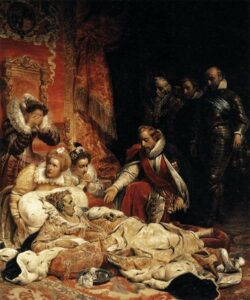
On this day in history, the 24th March 1603, Queen Elizabeth I died at Richmond Palace aged 69 bringing the rule of the Tudor dynasty to an end. Elizabeth I had reigned for 44 years and 127 days and her reign was known as “The Golden Age”. She was the longest reigning Tudor monarch.
Depression and Illness
It is said that the execution of her former favourite, Robert Devereux, the Earl of Essex, on the 25th February 1601 had a huge impact on Elizabeth. She had already lost her great love Robert Dudley in 1588, her good friend Blanche Parry in 1590 and her friend and adviser William Cecil, Lord Burghley, in 1598. It seemed that all those she loved and depended on were dying and leaving her. Her grief, combined with a belief that she was losing her grip on her court and country, led to her becoming severely depressed.
Tracy Borman, in her book “Elizabeth’s Women”, writes of how Elizabeth decided to move to Richmond Palace in January 1603 because it was the place to which she felt that she could “best trust her sickly old age”. She was obviously feeling low and ill and just wanted to be somewhere where she felt at home. Borman also writes of how it was in the last couple of months of her life that Elizabeth decided that she did not want her young ladies around her, instead she wanted older ladies who had served her for years, friends who she trusted.
In February 1603, Elizabeth’s health deteriorated and her depression worsened when she learned of the death of her friend the Countess of Nottingham, Catherine Howard (nee Carey), the niece of her great friend and cousin Catherine Carey, Lady Knollys. But even though she was depressed and ill, Elizabeth I still had her stubborn streak and refused to retire to her bed, choosing to stand for hours instead. When Robert Cecil told her that she must go to bed, she said to him:-
“The word must is not to be used to princes…little man, little man. Ye know I must died, and that makes ye so presumptuous.”
In desperation to try and get the Queen to rest, her ladies spread out cushions on the floor and Elizabeth did eventually give in and lie on these cushions. As her condition deteriorated, it is said that Elizabeth became delirious and was tormented by ghosts from her past and feelings of guilt over events like the execution of Mary Queen of Scots and the execution of the Earl of Essex.
By the 23rd March 1603 it was obvious that Elizabeth’s death was imminent. Archbishop Whitgift visited Elizabeth and it is said that the weak Queen squeezed his hand when he spoke of the rewards in Heaven that awaited her. Elizabeth’s ministers then gathered at her bedside, they needed to know who Elizabeth was going to choose as her successor. Elizabeth was now beyond speaking but when asked if it was her wish for James VI of Scotland to inherit the crown it is said that Elizabeth gestured with her hands, drawing a circle round her head to indicate a crown and confirm that this was indeed her wish. Elizabeth I died in the early hours of the next day, the 24th March, 1603. Diarist John Manningham wrote:
“This morning, about three o’clock her Majesty departed from this life, mildly like a lamb, easily like a ripe apple from a tree… Dr Parry told me he was present, and sent his prayers before her soul; and I doubt not but she is amongst the royal saints in heaven in eternal joys.”
Tracy Borman writes of how Lady Scrope took the sapphire ring that James VI had given her to use as a sign of the Queen’s death and dropped it out of the window to her brother, Sir Robert Carey, ordering him to take it straight to the new King, James VI of Scotland and James I of England.
G J Meyer, in “The Tudors: The Complete Story of England’s Most Notorious Dynasty”, writes of the dying Elizabeth being “a pathetic spectacle, all the more so because throughout her reign she has been vain to the point of childishness”. Meyer writes of how Elizabeth had lost most of her teeth, that she had suffered with hair loss, that she had refused to be attended to and bathed…but don’t we all look bad when we are dying? I am sure that those around her, people like the Earl of Nottingham, who begged her to get some sleep, and her ladies would not have seen their queen as pathetic, they loved and respected her.
As far as Elizabeth being ” vain to the point of childishness”, I see her “vanity” as being more to do with propaganda and creating a powerful image, than simple vanity. We have to remember that Elizabeth was a woman, a queen but a woman, ruling a country in a man’s world and it was imperative that she projected a strong image and even more so as she grew older and went into decline.
Cause of Death
G J Meyer writes that the doctors probably had no idea of why Elizabeth was dying and that it could have been any of the following:-
- A bronchial infection that turned into pneumonia
- Streptococcus
- The failure of some vital organ
- Poisoning from ceruse – the white lead and vinegar mixture that Elizabeth used as make-up.
But G J Meyer writes that whatever the actual medical condition it does appear that it was aggravated by Elizabeth’s state of mind, her depression.
The Funeral of Elizabeth I
The body of Queen Elizabeth I was place inside a lead coffin and carried by night by a torchlit barge along the Thames from Richmond Palace to Whitehall where the Queen was to lay in state until her funeral, giving time for King James to travel down to London. While the coffin lay in state, a life size effigy of the Queen, dressed in her royal robes, was placed on top of it to act as a symbol of the monarchy while there was no monarch in England.
On the 28th April 1603, Elizabeth’s coffin was carried from Whitehall to Westminster Abbey on a hearse drawn by horses hung with black velvet. The coffin was covered in a rich purple cloth, topped with the effigy of Elizabeth with a sceptre in her hands and a crown on her head. Above the coffin was a canopy supported by six knights and behind the hearse was the Queen’s Master of the Horse, leading her palfrey. The Chief Mourner was the Countess of Northampton who led the party of peers of the realm, all dressed in black. Chronicler John Stow wrote:-
“Westminster was surcharged with multitudes of all sorts of people in their streets, houses, windows, leads and gutters, that came out to see the obsequy, and when they beheld her statue lying upon the coffin, there was such a general sighing, groaning and weeping as the like hath not been seen or known in the memory of man.”

Elizabeth was then buried at Westminster Abbey in the vault of her grandfather, Henry VII, until she was moved in 1606 to her present resting place, a tomb in the Lady Chapel of Westminster Abbey which she shares with her half-sister Mary I. King James I spent over £11,000 on Elizabeth I’s lavish funeral and he also arranged for this white marble monument to be built. The tomb is inscribed with the words:-
“Consorts both in throne and grave, here we rest two sisters, Elizabeth and Mary, in hope of our resurrection.”
The Tomb and Funeral Effigy of Elizabeth I
You can see an 18th century copy of the funeral effigy that was carried on Elizabeth I’s coffin at the Westminster Abbey Museum and there is a photo of it at www.20thcenturylondon.org.uk. You can also visit the Westminster Abbey page on Elizabeth I’s tomb at http://www.westminster-abbey.org/our-history/royals/burials/elizabeth-i.
Rest in peace, Gloriana and Virgin Queen, today we toast your memory.
Sources
- UK Parliament website – Page on the death of Queen Elizabeth I
- “Elizabeth’s Women”by Tracy Borman
- “The Tudors: The Complete Story of England’s Most Notorious Dynasty” by G J Meyer








